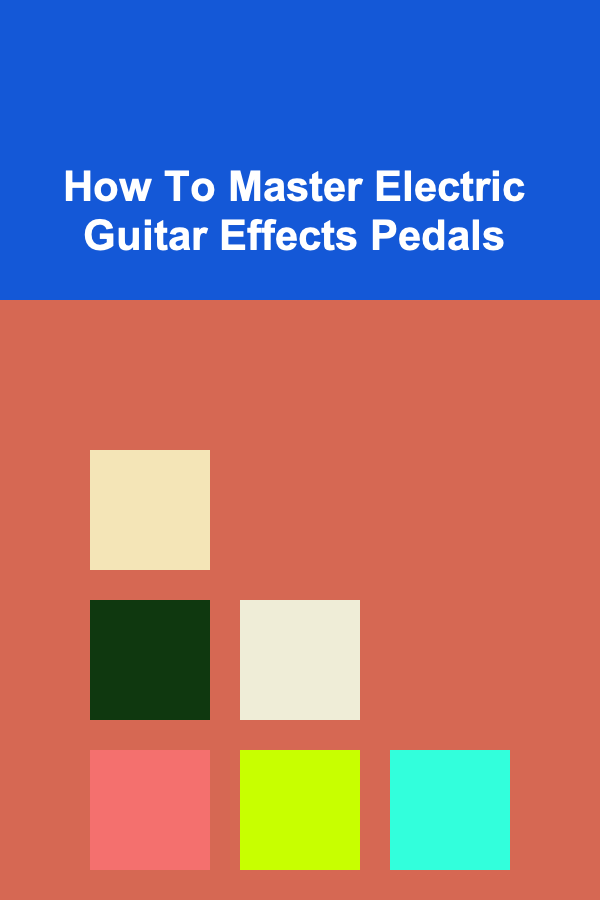
How To Master Electric Guitar Effects Pedals
ebook include PDF & Audio bundle (Micro Guide)
$12.99$11.99
Limited Time Offer! Order within the next:

Electric guitar effects pedals have revolutionized the sound of modern music, offering guitarists the ability to shape and manipulate their tone in countless ways. Whether you're a beginner just starting with your first pedal or an experienced guitarist aiming to refine your pedalboard setup, understanding how to master electric guitar effects pedals is essential for creating your signature sound.
This comprehensive guide will walk you through the different types of guitar effects pedals, how to use them, and how to integrate them into your playing to enhance your overall performance. By the end of this article, you will be equipped with the knowledge to explore the endless possibilities that electric guitar effects pedals provide.
The Basics of Guitar Effects Pedals
Before we dive into the specifics of each type of pedal, it's important to first understand what guitar effects pedals are and how they work.
What Are Guitar Effects Pedals?
Guitar effects pedals are small electronic devices that modify the sound of an electric guitar. They sit between the guitar and the amplifier in the signal chain and manipulate the guitar's tone in various ways. Pedals come in different types, each designed to achieve a specific effect. They can add reverb, delay, distortion, modulation, and more, transforming a clean, pure guitar signal into something unique and expressive.
Signal Chain Basics
The signal chain refers to the path your guitar signal follows from the instrument, through the effects pedals, and into the amplifier. The order in which you place your pedals in the signal chain affects the sound you achieve. Some effects work better when placed at the beginning of the chain (such as distortion), while others perform best when placed toward the end (like delay and reverb). Understanding how the signal chain affects your tone is one of the first steps in mastering your pedal setup.
The Power of Experimentation
One of the most exciting aspects of using guitar effects pedals is the ability to experiment. There are no hard and fast rules about how to set up your pedalboard, and part of mastering pedals involves exploring different combinations and settings. By experimenting with different pedals, placement, and settings, you can discover a multitude of unique sounds and textures.
Types of Guitar Effects Pedals
To truly master effects pedals, it's crucial to understand the different types and how they work. Here's an in-depth look at the most common types of guitar pedals:
1. Distortion, Overdrive, and Fuzz Pedals
These pedals are often used to add "dirt" or saturation to the guitar signal, producing a more aggressive or gritty tone.
- Distortion Pedals: Distortion pedals are used to heavily alter the sound of the guitar, adding sustain and harmonic richness. They create a saturated, "fuzzy" tone that's commonly used in rock, metal, and punk genres. Distortion pedals are typically placed early in the signal chain, as they work best when they have a clean signal to process.
- Overdrive Pedals: Overdrive pedals simulate the sound of an overdriven tube amplifier. They produce a smoother, more organic distortion than a standard distortion pedal and are used to add warmth and dynamic response to the tone. Overdrive pedals can be used to add subtle edge to your sound or to push your amp into full saturation.
- Fuzz Pedals: Fuzz pedals take distortion to the extreme, resulting in a very aggressive, often chaotic sound. They produce a thick, squashed tone that's perfect for creating vintage-sounding leads or heavy, saturated riffs. Fuzz pedals can sometimes be tricky to control, but they are incredibly effective in creating bold, distinctive sounds.
2. Modulation Pedals
Modulation pedals manipulate the frequency of your guitar signal, resulting in a variety of time-based effects. These pedals are designed to add movement and depth to your sound.
- Chorus Pedals: Chorus pedals add a shimmering, wavy effect to your sound by duplicating the guitar signal and slightly delaying one of the copies. The result is a lush, thickened tone that's perfect for clean or rhythmic playing.
- Flanger Pedals: Flangers are similar to chorus pedals but produce a more pronounced, jet-like sound. They create a "whooshing" effect by combining the original signal with a delayed version that is modulated in pitch. Flanger pedals are popular in both rock and electronic music for their ability to create dramatic sonic textures.
- Phaser Pedals: Phaser pedals create a sweeping, spacey sound by splitting the signal and modulating one side with a series of peaks and valleys. The result is a "swirling" or "swooshing" effect that adds movement to your sound.
3. Delay and Reverb Pedals
Delay and reverb pedals are two of the most commonly used effects for adding space and dimension to the guitar sound.
- Delay Pedals: Delay pedals replicate the guitar signal, introducing a slight echo effect. By adjusting the delay time and feedback levels, you can create anything from a short slapback echo to long, ambient repeats. Delay is often used to add depth and atmosphere, as well as to create complex rhythmic patterns.
- Reverb Pedals: Reverb pedals simulate the natural reflections of sound in a physical space, such as a room, hall, or church. They add ambiance and depth to your tone, making it sound as though it is being played in a larger, more resonant environment. Reverb is often used to "fill out" a guitar sound and provide a sense of space.
4. Dynamic Pedals
Dynamic pedals affect the dynamics of your playing by responding to the input signal's intensity.
- Compressor Pedals: A compressor pedal smooths out the dynamic range of your guitar by reducing the volume of louder notes and boosting softer ones. This results in a more even, consistent sound and can be particularly useful in genres like country or funk.
- Volume Pedals: A volume pedal allows you to control the overall volume of your signal without affecting other pedal settings. These pedals are often used for swells, fade-ins, or to control the volume of specific parts of a song.
5. EQ Pedals
EQ (Equalizer) pedals allow you to adjust the frequency response of your guitar signal, boosting or cutting specific frequencies. They're essential for sculpting your tone, especially if you want to fine-tune your sound to fit specific musical contexts.
- Graphic EQ Pedals: These pedals provide multiple sliders that control the levels of various frequency bands. They offer precise control over your tone and are particularly useful in live settings, where you might need to adapt to different room acoustics.
- Parametric EQ Pedals: Parametric EQ pedals give more detailed control over individual frequency ranges, allowing you to adjust the frequency, bandwidth, and gain of each band. These are ideal for musicians who want maximum control over their sound.
6. Looper Pedals
Looper pedals allow you to record a section of your playing and then loop it indefinitely. They are often used for live performances or for practicing improvisation and layering. With a looper, you can create complex, multi-layered compositions on the fly.
How to Build Your Pedalboard
Building a pedalboard is a critical part of mastering guitar effects pedals. Not only does it allow you to keep your pedals organized, but it also lets you experiment with the order of your pedals and create a setup that suits your musical style.
1. Choosing Your Pedals
When building your pedalboard, start with the basic effects that suit your playing style. For beginners, it's a good idea to start with a tuner, distortion, delay, and reverb. As you progress, you can add modulation, EQ, and other effects to expand your sound palette.
2. Pedal Order
The order of your pedals is crucial in shaping your sound. Here's a typical signal chain order:
- Tuner
- Dynamics (Compressor)
- Distortion/Overdrive/Fuzz
- Modulation (Chorus, Phaser, Flanger)
- Delay
- Reverb
However, feel free to experiment with different orders to achieve unique sounds. For example, putting delay before overdrive can create an entirely different tonal character than putting delay after.
3. Power Supply
Most pedals require a power source, and some may need specific power adapters or isolated power supplies to avoid noise or interference. Investing in a quality power supply is crucial for ensuring that your pedals perform optimally.
4. Pedalboard Layout
Organize your pedals on your pedalboard in a way that's both functional and easy to navigate. Pedals that you use most often should be easily accessible, and make sure to leave enough space for any future additions.
Advanced Techniques for Using Pedals
Once you've mastered the basics, you can start experimenting with more advanced techniques to enhance your sound even further.
1. Stacking Pedals
Stacking pedals refers to using multiple pedals together to achieve a specific sound. For example, you might combine an overdrive pedal with a distortion pedal to create a more intense and saturated tone. Stacking can create a wide range of effects, and part of mastering pedals is learning how different pedals interact with each other.
2. Creating Ambient Soundscapes
By combining delay, reverb, and modulation pedals, you can create lush, atmospheric soundscapes. Experiment with long delay times, heavy reverb, and chorus effects to generate ambient textures perfect for introspective or cinematic music.
3. Using Expression Pedals
Some pedals, like delay and modulation effects, can be controlled with an expression pedal. This allows you to manipulate the effect in real-time, adding dynamics and variation to your playing. Experiment with using an expression pedal to adjust delay feedback, modulation depth, or reverb decay.
Conclusion
Mastering electric guitar effects pedals requires patience, experimentation, and a deep understanding of how each pedal works. With time, you'll learn how to combine and control different effects to create your unique sound. Whether you're playing in a band or recording solo, mastering pedals will allow you to add depth, texture, and nuance to your music, opening up endless creative possibilities.
Remember, there are no rules when it comes to effects pedals. The most important thing is to find what works for you and to have fun exploring the vast array of sounds you can create with these tools. Happy playing!

How to Avoid Common Mistakes First-Time Landlords Make
Read More
How to Plan a Backyard Campout for Quality Family Time
Read More
How to Start Your Own Courier Delivery Business with Minimal Investment
Read More
How to Explore the Myths of the Norse Sagas
Read More
How To Discover New Treatments for Chronic Kidney Disease
Read More
How to Ace Your Account Executive Interview: A Comprehensive Guide
Read MoreOther Products

How to Avoid Common Mistakes First-Time Landlords Make
Read More
How to Plan a Backyard Campout for Quality Family Time
Read More
How to Start Your Own Courier Delivery Business with Minimal Investment
Read More
How to Explore the Myths of the Norse Sagas
Read More
How To Discover New Treatments for Chronic Kidney Disease
Read More